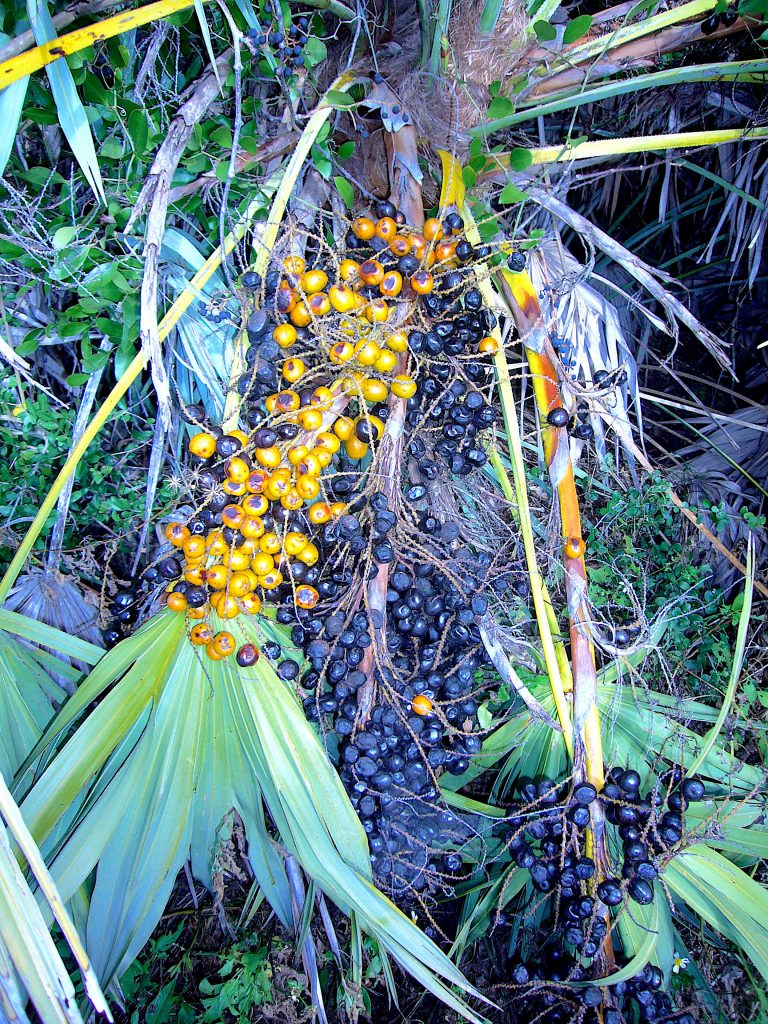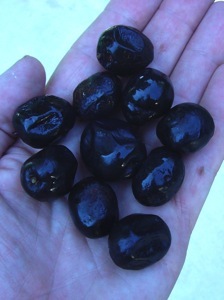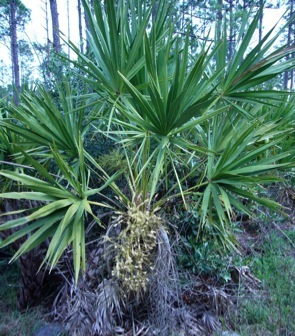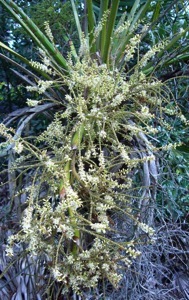Serenoa Repens: Weed to Wonder Drug
Rotten cheese steeped in tobacco juice
That’s how starving shipwrecked Quakers described the flavor of the saw palmetto berries in 1692, “rotten cheese steeped in tobacco juice.” The account is in a 103-page report on Saw Palmetto written by Dr. Edwin Moses Hale in 1898:
“There is no doubt that the aborigines of the Florida peninsula depended largely upon the berries of the saw palmetto for their food. In a very old book, with a quaint title page, published in 1796, are narrated by Jonathan Dickinson the adventures of a shipload of Quakers who were shipwrecked on the coast of Florida… The shipwreck occurred [24 September] 1696. They were captured by the Jaega Indians, who were believed to be cannibals. After terrible sufferings, a part of the men and women arrived at St. Augustine. Dickinson narrates that on their [capture] they were taken to the wigwam of the “casseky” or chief who “seated himself on his cabin, cross legged, having a basket of palmetto berries brought him, which he eat very greedily.” These Quakers, while with the Indians, nearly starved to death. The only food given them were fish and berries. Their first trial of the berries was not favorable. “We tasted them, but not one among us could suffer them to stay in our mouths, for we could compare the taste of them to nothing else by rotten cheese steeped in tobacco juice. …. of the palm berries we could not bear the taste in our mouths.” Even when almost starving “the Indians offered us some of their berries, which we endeavored to eat but could not; the taste was so irksome and ready to take out breath from us when we tried to eat them.”
Hale, quoting Dickinson, goes on to say the Quakers did learn to tolerate the berries and the boiled juice of the saw palmetto helped feed and save Dickinson’s infant son. That makes sense: The berry is loaded with oil and sugar. In his book, the good doctor also describes eating them: “The berries are at first exceedingly sweet to the taste, but in a few seconds this is followed by an acrid, pungent sensation that spreads to the fauces, nasal mucous membrane and larynx. This is in turn succeeded by a feeling of smoothness in all those parts, as if they had been coated with oil.” He likened the flavor to butyric acid that grows stronger with age.
Some Internet pundits — no doubt copying each other — call the shipwrecked account about eating the berries humorous. That is woefully misplaced. Their ship, the Reformation, a barkentine sailing from Jamaica to Philadelphia, was wrecked off Jupiter Island, near Hobe Sound, by a hurricane. Twenty survived the wrecking and subsequent “capture.” And though starving they had to wrestle with the idea the Indians wanted to fatten them up for slaughter — cannibals only eat strangers. Released after several weeks of captivity they had to make their way on foot the 230 miles up the coast to St. Augustine, five of them died along the way from starvation and exposure. No food, no water, in a hostile strange land with often hostile natives. Hardly humorous. They were semi-captured as second time by the Ais Indians and endured yet another hurricane. One can still read of the harrowing account in Dickinson’s narrative (abbreviated title) : God’s Protective Providence, Being the Narrative of a Journey from Port Royal in Jamaica to Philadelphia Between August 23 1696 and April 1, 1697. The book was reprinted 16 times in English, and three times each in Dutch and German between 1700 and 1869. Today it is known as Jonathan Dickinson’s Journal. Dickinson, by the way, went on to twice serve as mayor of Philadelphia. There is now an 11,500-acre state park in Florida, the Jonathan Dickinson State Park, about five miles from where they were shipwrecked.
Personally, I think the black ripe berries of the Serenoa repens (sair-ren-NOE-uh REE-penz) tastes like an extremely intense, very long-lasting, exceptionally peppery piece of blue cheese. It is also very close in flavor to the gastric juices we sometimes burp up and coats our throat. Blue cheese/gastric juice, intense, mouth coating, near burning. Discarding the seed unless I plan on squeezing it for oil, I eat one berry at a time, with wine, and still it is very intense blue cheese-esque…. not as good as blue cheese, but more intense, on the verge of being gastric juice. Not something to eat without a chaser… you have been warned.
Old time Seminole Indians said you shouldn’t eat more than five palmetto berries at one time. If you eat it with hot water it will bother your mouth for a while. They may know a thing or two about that. They still squeeze the berries, but add a little sugar with the juice, and drink it as a tea. In the early 1900’s in Miami you could buy “Metto” which was saw palmetto juice mixed with sugar and carbonated water. And as much as Dickinson said none of his party could eat them the berries were exported to Europe nearly as century earlier in 1602.
Fortunately for us there is more to forage off the saw palmetto than the berries. The terminal buds of the growing trunks contain heart of palm just like the cabbage palm does except it’s smaller. Taking it from the saw palmetto does not kill the many-trunked palm. The growing bottom ends of young fronds are also edible, after one carefully pulls them out. You get one or two bites off those but it is work hauling them out. You pull them out by putting on some thick leather gloves, grabbing the youngest stalk firmly, and yanking. Where it breaks is edible. Also the stems can be chopped, ground, mixed with water, strained and an edible starch settled out.
The Saw Palmetto cover about 10% of the state of Florida and is a major source of honey. There are actually two varieties, one with yellow green fronds and ones with blue green fronds. Both of them also produce wax in their leaves but the wax from the blue green variety is preferred. Besides that the plant is used for fiber and thatching. Seminole Indians still make their dolls out of 100% saw palmetto fiber. It stems provide a good cork substitute, the root pulp was used to plug WWII ammunition, and the root makes a natural scrub brush.
In a modern day twist the saw palmetto berries have several medical application so this “irksome” weed is a $70 million or more business in Florida. They’ve even had to pass laws to prevent unauthorized saw palmetto berry pilfering. Has a $500 fine. We now know saw palmetto berries have a positive effect on the male reproductive system, though the studies are mixed. Older Seminole Indians called the berries the “spring of life.” Some think this is where Ponce De Leon got the idea there was some fountain of youth in Florida. Talk about a mistranslation. I processed 10 pounds of berries. Five pounds were dehydrated, and five went into vodka. The dried saw palmetto berries had a milder flavor. The ones in vodka moderated, too, but took on a tougher texture like think cardboard.
Incidentally, be careful when foraging for palmetto berries. Palmetto thickets are favorite place for the Eastern Diamondback Rattlesnake, not only on the ground but in the fronds. The snake often climbs the plant on sunny days to get off the hot ground and enjoy the shade. It is also where their prey like to escape as well. Proceed carefully. Creatures that like to eat the berries include raccoon, fox, black bear, gopher tortoises, white tailed deer, feral hogs, water birds and even fish. Butterflies like it, too. In fact the plant provides food or cover for some 100 birds, 27 mammals, 25 amphibians, 61 reptile species and numerous butterflies. Cows fed saw palmetto berries produce richer milk, perhaps because the berry is loaded with oil. Two thirds of the oil is comprised of free fatty acids including capric, caprylic, caproic, lauric, palmitic and oleic acids.
Incidentally, the heart of the Sabal etonia aka Sabal minor can also be eaten. It resembles the saw palmetto but its stalks have no saw-like teeth. It is also rather rare, so don’t put it on your dinner plate unless it is development kill.
The genus, Serenoa, is named for shy Harvard botanist and herbarium curator Sereno Watson, 1826-1892. His name means calm, peaceful. Repens means “creeping.” The palm has many branches and creeps out in all directions along the ground.
Green Deane’s “Itemized” Plant Profile
IDENTIFICATION: A small palm, six to twelve feet, sprawling, grows in clumps or dense thickets. Leaf stalks are covered with saw like teeth.
TIME OF YEAR: Fruits ripen in fall, heart available year round.
ENVIRONMENT: Sandy ridges, flatwood forests, coastal dunes, islands near marshes, hardwood hammocks, dominant ground cover in some southeastern pine forests, sometimes covering hundreds of acres. Seen inland as far as Arkansas
METHOD OF PREPARATION: Fruits raw or dried, heart raw or cooked. Crown end of growing leaf, trail side nibble. The seeds are edible raw or cooked but is an acquired taste.







